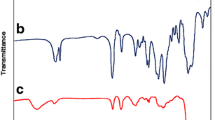Abstract
Sol–gel derived poly(methyl methacrylate)–titania hybrid materials were synthesized by using acrylic acid or allyl acetylacetone (3-allyl-2,4-pentanedione) as coupling agent. Titanium butoxide modified with acrylic acid (or titanium isopropoxide modified with allyl acetylacetone) was hydrolysed to produce a titania network, and then poly(methyl methacrylate) (PMMA) chains, formed in situ through a radical polymerization, were chemically bonded to the forming titania network to synthesize a hybrid material. Transparent hybrid materials with different contents of titania were achieved. With increase of the titania content, the colours of the products changed from yellow to dark red. The synthesis process was investigated step by step by using Fourier transform–infrared spectroscopy, and the experimental results demonstrated that acrylate or acetylacetonato groups bound to titanium remain in the final hybrid materials. The thermal stability of the hybrid materials was considerably improved relative to pure PMMA. Field emission scanning electron microscopy analyses showed the hybrid materials are porous and pore diameters vary from 10–100 nm. The hybrid materials using allyl acetylacetone as coupling agent exhibited a thermochromic effect that neither pure PMMA nor titania exhibit.
Similar content being viewed by others
References
H. K. SCHMIDT, in “Inorganic and Organometallic Polymers with Special Properties”, edited by R. M. Laine (Kluwer Academic, New York, 1992) p. 297.
H. SCHMIDT and G. PHILIPP,J. Non-Cryst. Solids 63 (1984) 283.
J. HU and J. D. MACKENZIE, in “Better Ceramics Through Chemistry”, MRS Symposium Proceedings, Vol. 271, editors M. J. Hampden-Smith, W. G. Klemperer and C. Jeffrey Brinker (Materials Research Society, Pittsburgh, PA, 1992) p. 681.
H. HUANG, B. ORLER and G. L. WILKES,Polym. Bull. 14 (1985) 557.
Idem,Macromolecules 20 (1987) 1322.
B. WANG, G. L. WILKES, C. D. SMITH and J. E. McGRATH,Polym. Commun. 32 (1991) 400.
M. NANDI, JEANINE A. CUNKLIN, LAWRENCE SALVATI JR and AYUSMAN SEN,Chem. Mater. 3 (1991) 2021.
R. H. GLASTER and G. L. WILKES,Polym. Bull. 22 (1989) 527.
G. PHILIPP and H. SCHMIDT,J. Non-Cryst. Solids 82 (1986) 31.
B. M. NOVAK,Adv. Mater. 5 (1993) 422.
R. B. DAVIS and P. HURD,J. Am. Chem. Soc. 77 (1955) 3284.
K. NAKAMOTO, “Infrared and Raman Spectra of Inorganic and Coordination Compounds”, 3rd Edn (Wiley, New York, 1978).
A. LEAUSTIC, F. BABONNEAU and J. LIVAGE,Chem. Mater. 1 (1989) 240.
Author information
Authors and Affiliations
Rights and permissions
About this article
Cite this article
ZHANG, J., LUO, S. & GUI, L. Poly(methyl methacrylate)–titania hybrid materials by sol–gel processing. Journal of Materials Science 32, 1469–1472 (1997). https://doi.org/10.1023/A:1018553901058
Published:
Issue Date:
DOI: https://doi.org/10.1023/A:1018553901058




